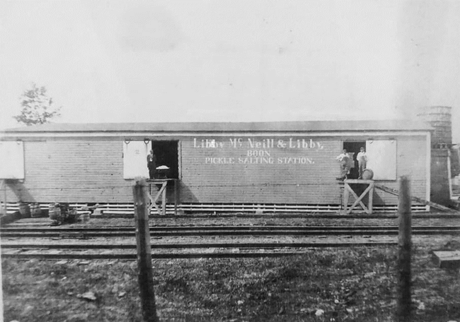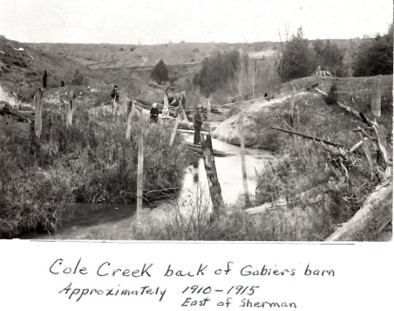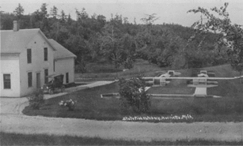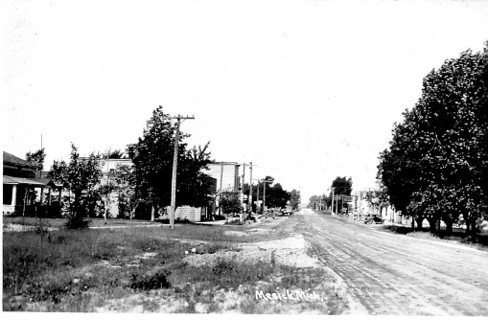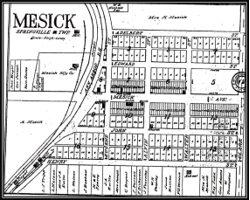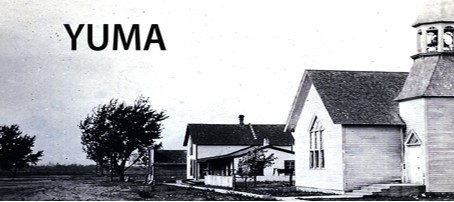The value of trees began to grow as buildings were constructed. Early in 1867, the first sawmill in Wexford County was built by John Wheeler, located on Wheeler Creek. Soon Moses Cole built on Cole Creek, then another mill was built by the Fletcher Brothers on Fletcher Creek, and all were powered by water. And so, the lumbering era began in the northeast corner of Wexford County causing Sherman to be platted in 1869 by Sanford Gasser.
The first courthouse of Wexford county was built in Sherman, and it became an aristocratic village planned especially for the well-to-do family. Wealthy lumbermen built mansions there and vied with each other for owning the best house in town. Sherman grew to a town of 650 inhabitants and lasted for 50 years.
By 1871 the Manistee River Improvement Company in anticipation of the log jams, when lumbermen sent them down the river, was estimating the cost of removing the jams. (An extremely dangerous job for the river men). Eventually, the Manistee river was cleared, and logs could easily be floated to the mills. It was then that Howard Mesick began to realize the value of lumber. Make no mistake, Howard had an entrepreneur’s heart. Soon hope of a railroad became a reality.
James Ashley was the man that made it possible for the Ann Arbor Railroad to be built from Clam Lake through Boon, Harrietta, Yuma, Mesick, Harlan, and on through Manistee county. (In total, the Ann Arbor Railroad extended from Toledo, Ohio to Frankfort, Michigan). Each of the previously mentioned settlements acquired a post office.
Boon had two sawmills that were built nearby along with the railroad. Charcoal kilns, a handle factory, bank, stores, and two churches (Baptist & Free Methodist) were soon constructed. In August of 1892, a plat of Bennett’s addition was filed. The panic of 1893 put a stop to the mills and Boon went into a decline at its peak. The population of Boon probably never exceeded 150 to 175 people.
Harrietta in its heyday had a population of close to five hundred, two sawmills, a handle factory, a table-leg factory, a stove factory, a brick factory, and a chemical plant for the manufacture of alcohol and other wood by-products. And in 1901 the state built a fish hatchery on Slagle Creek near the village.
Yuma began as a logging camp centered around Sand’s Camp and Yuma Purchase’s boarding house on the Old State Road. Roland Jenny’s Harrietta charcoal and chemical plant for the manufacture of alcohol and other wood by-products was moved to Yuma in 1888. The lumbering and the charcoal and chemical plant were the main uses of the railroad and the village flourished during those years.
Mesick became a village in 1889 after the Ann Arbor Railroad was built across the land homesteaded by Howard and Eleanor Mesick. The charter for Sherman had been drawn up in 1887 with the expectation of the railroad coming there. When that expectation failed, it was a big upset to their community, but it gave rise to a trading post in Springville with Howard Mesick building the first general merchandise store to accommodate the people.
Harlan is a ghost town that lies in Cleon Township in Manistee County, a few miles southeast of Copemish. (Harlan in earlier years was set over in Wexford county.) The first settler arrived in 1857 with a team of oxen from Benton Harbor. In 1889, the Toledo, Ann Arbor & Northern Railroad relocated, going through Harlan and the town experienced amazing growth. Within a couple of years, the town had a blacksmith, church, depot, two general stores, hotel, pickle factory, post office, potato storage warehouse, two sawmills, schoolhouse, and a telephone operator. By 1912 the population of Harlan was 75. But eventually, prosperity began its decline. The post office shut down in 1935, the school and church in the 1950s, and the main general store in 1959. In the 1970s, the Sargent Sand Company built a plant east of town, giving Harlan a little resurgence. But It too has dwindled to nothing.
Glengary a settlement near Mesick is located at the foot of the greatest range of hills in the Lower Peninsula, (hills that would be called mountains in some parts of the country) where the Manistee River runs through the valley you will find it. It did not have an Ann Arbor Railway through, however, Northern and Indiana accommodated that area. In the day Glengary boasted a furniture factory, a department store, one hotel, a pool room, and 22 dwelling houses. Many of the 150 factory workers lived in the village while others come from Mesick and Sherman. The factory was built in 1910 and operated until 1917. The building was then turned into a pickle plant that lasted about a year. Now, most of the buildings are gone, and slowly nature has pushed it back into the wilderness whence it derived.
Gallery


